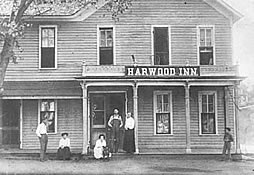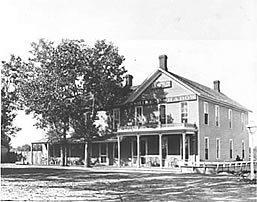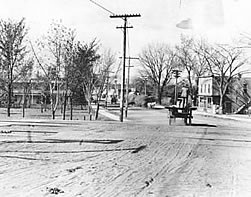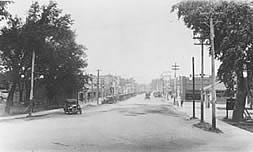Early Hotels in Littleton
In the early history of Littleton, hotels were needed to provide rooms for visitors and as places to purchase good meals. A hotel called the Bell House was the first hotel in Littleton; it was established in 1869.Built by "Mr. Bell" on Santa Fe Drive across from the Rough and Ready Flour Mill, this establishment provided housing for mill workers at the nearby mill. Mr. Bell also constructed Littleton's first log schoolhouse in 1865.
The Harwood Inn

The Harwood Inn, c. 1876-late 1880s. The inn was built in 1869 on the southwest corner of Rapp St. and Bowles Ave. It was sold in 1896 and renamed the Sunshine and Shadow Hotel.
In 1876, John and Mary Harwood purchased the Bell House property and renamed it the Harwood Inn. The Harwoods were the parents of Mrs. Angelina Little, wife of town founder Richard Little.
Soon stagecoaches began stopping there and travelers made the hotel a favorite spot where they could enjoy the wide lawn and shade trees. A circular drive in front of the hotel drew residents and tourists to come and relax on the property. A bandstand constructed on the lawn proved a perfect place for politicians to give impromptu speeches. Ladies in their fine white dresses and gentlemen in dark suits and bowler hats strolled the grounds waiting for the political candidates to begin to speak.
A notice in the Littleton Independent (Sept. 8, 1888) stated:
The Harwood house, presided over by Mr. A. E. Finn, is gaining much popularity among the pleasure seekers of Denver.
In 1888, the new newspaper, the Littleton Gazette, was printed in the hotel basement so events occurring around the hotel could be quickly chronicled. H.V. Bullock was the first editor of the paper, and Richard Little ordered the very first subscription, at a cost of $2.
This two-story hotel with its tall trees and pleasant surroundings would certainly have been a good choice of lodgings for visitors from other states as well as Colorado. An addition was built after 1888 to accommodate the demand for rooms. An ad promoting the Harwood House appeared daily on the first page of the Littleton Independent.
A $2.50 ticket for the Harwood House Hop in 1881 was a day's wages for many people.
As was customary in those days, the Harwood sent lists of their guests to be printed in the local paper, and long lists they were. The Harwood was completely full in 1888, and regularly turned away guests. The reason was that this hotel catered to the infirm, those with tuberculosis, the "lungers." Physicians from Denver often recommended the hotel for rest and relaxation, so couples and families traveled the 12 miles from Denver by carriage, train, and horse to spend a few quiet days at this splendid hotel. The rates of $2.00 to $2.50 per day discouraged the less well-to-do from inquiring. Weekly and monthly rates were also available. The employees worked hard providing for the wishes of the guests by providing excellent food and lots of delicacies.

Sunshine and Shadow Hotel, c.1898. It was formerly known as the Harwood Inn.
In 1889, George and Gil Belcher, and Andy Finn purchased the hotel and renamed it the Midway Hotel. This change in management did not last long and H. Dean bought it in 1892. He continued to use the name Midway Hotel.
In 1896, Mr. and Mrs. Charles A. Treat purchased the Harwood House/Midway Hotel and changed the name to Sunshine and Shadow. It became a rest stop for health conscious bicyclists enjoying the new fad of cycling. This new name became the most recognized name for the hotel.
In 1915, W. H. Caley purchased the hotel. Shortly afterward, there was a serious fire at the hotel. Caley decided to demolish the building in order to erect four "modern cottages" fronting Rapp Street. The local paper stated, "The old structure stood as a landmark in the history of Littleton's progress." A part of early Littleton had disappeared.
The Belcher Hotel, Littleton Hotel, and Royal Hotel

Main Street looking west, c.1908. Building on left is the Belcher Hotel. On right is the Last Chance Saloon.
The Harwood was not the only hotel serving Littleton in the early days. George Belcher established the Belcher House on Main Street near the train depot in 1890 and advertised daily in the Littleton Independent:
This new Hotel and Restaurant has been especially fitted up for the accommodation of the traveling public. The table will be furnished with the best the market affords, and no expense will be spared in making the guests as comfortable as possible. Meals at all reasonable hours.
The hotel owner, George Belcher, a native of Pennsylvania, and his wife, Ellen, moved to Littleton after spending several years in Golden where they owned a ranch. George passed away in December, 1891 after a lengthy illness attributed to many months spent under harsh conditions in prisoner of war camps during the Civil War. He was only 60. His brother, Gilbert, took over operations of the hotel, but he passed away four years later in May, 1895, also at age 60. In 1900, J. McAdams was the proprietor of the hotel. J.W. Blue purchased it in 1902.
Blue was considered by many in Littleton to be one of the "best known men in this part of the country." He owned a saloon and restaurant in town. At the time he purchased the hotel, it was called the Kirchgraber. Blue turned it into a "first class boarding house." Meals were offered for 25 cents for an introductory period.
Blue added a second story to the Belcher Hotel. The hotel then became the Littleton Hotel. Blue operated it for several years. In 1912, L.F. Fowler operated the hotel. In 1924-25, the new owner, Ulva C. Thomas put a brick front on the hotel and added three or four stores to the east. A catchy sign at the hotel stated:
Room and a bath for a dollar and a half;
Nothing extra for your wife.
As Houstoun Waring, editor of the Littleton Independent, related in one of his columns, he spent his first night in Littleton at the Littleton Hotel, discovering there was only one bath per floor, and lots of noise from the trains.

Main Street, c.1930, looking west from the Denver and Rio Grande Railroad Depot when it was at the east end of the street. The Hotel Royal, later called Littleton Hotel, is on the left.
Part of the hotel was leased to Mr. and Mrs. E.D. Hull. Another unit was leased as the Royal Cafe and Hotel. The remainder was leased by George Kinkel for a meat market. Inside that store was a connecting door to George Bancroft's grocery. Later, the Workman Studio was located in one of the units. The hotel, located at 149 West Main, was called the Hotel Royale in the 1934 town directory and John Ewing was the proprietor.
Edwin Watson purchased the hotel building in 1952. The add-on shop units were torn down in March 1971, in order to construct a drive-in entrance to the Littleton National Bank. Later tenants included W.K. Rader Grocery, and Red Comet, Inc.
The Saar Hotel
The Saar Hotel still stands about one block off Littleton Blvd. at 5621 S. Nevada Street. This unusual three-story structure seems to dwarf the other houses on the block. William T. Murrell built the house as a single-family residence of only two stories in 1891. The first floor was originally brick, with fish scale siding on the second floor. In 1905, Murrell sold the house to a local lawyer, Daniel Prescott and his wife, Eleanor.
The Prescotts had four children and entertained at their Littleton house. They added a complete third floor, making the house quite large and towering. It was the scene in 1911 for an important social event, as their daughter Katherine, married the prominent journalist, Edwin Bemis on July 20. At the time, Ed Bemis owned the Bemis Book Store and was serving his second term as town treasurer.
Prescott died in July 1915 of a stomach ailment. Eleanor eventually decided to sell the extra-large house. It became the Duman Hotel in the 1920s and the Saar Hotel in the 1930s. Weekly luncheons for the Rotary Club were held in the Saar restaurant.
John Hamilton owned the house from 1946 to 1980 and converted it to a boarding house.
In 1980, Ed Weisbrot bought the house and contents and found mostly antiques. He maintained it as a rooming house with 11 sleeping rooms, but no cooking privileges.
Today the house is little changed from old photos showing the large covered front porch and the asymmetrical front facade. On the second floor, above the front door, there is a horizontal window, just one, while all the other windows are vertically set. The wide eaves that overhang the third story walls and the fish scale siding on the upper two floors stand out as unusual features. The historical consultants who completed the historical survey for the City of Littleton determined this house to not be individually eligible for the National Register. It is however, a contributing element to the historic district.
The Commercial Hotel
Little is known about the Commercial Hotel. It was located near the depot, and was owned and operated by Thomas Carrigan and James Bowlen in 1904. Henry Smith managed it in 1905. The rates were $1 to $2 per day. The daily ad in the Littleton Independent stated, "Strictly First Class."
The Willowcroft Manor
The quaint Willowcroft Manor, 1/2-mile west of Littleton, was opened by the Civic and Commercial Club of Littleton on July 14, 1923. The decor of the hotel was quite elegant. The formal banquet hall stood to the left of the front door, decorated in soft French gray interspersed with window shades of rose-colored parchment and mahogany furniture upholstered in blue leather. French doors opened onto terraces on all sides, bringing the outdoors to the guests.
J.R. Moler operated the hotel, staying in a comfortable apartment opposite the dining hall. Willowcroft sponsored public dances on Wednesdays and Saturdays, and was available for special functions.
Bibliography
Littleton (Colo.) Independent. The Littleton Independent Publishers, 1888-.
Freemasons of Littleton, Colorado. Weston Lodge Number 22, A. F. & A. M., 1872-1973. Littleton:
Hicks, Dave. Littleton From the Beginning. Denver : Egan Printing, 1975.
Littleton Museum. Card files.
Simmons, R. Laurie and Thomas H. Simmons. "Historic Buildings Survey, Littleton, Colorado, Littleton Townsite of 1890." Three volumes. Denver: Front Range Research Associates, Inc., 1997, 1998.
Photographs courtesy of the Littleton Museum unless otherwise noted. To order copies, contact the museum at 303-795-3950.
Compiled by Rebecca Dorward
Edited by Phyllis Larison and Lorena Donohue
Updated April 2021 by Phyllis Larison